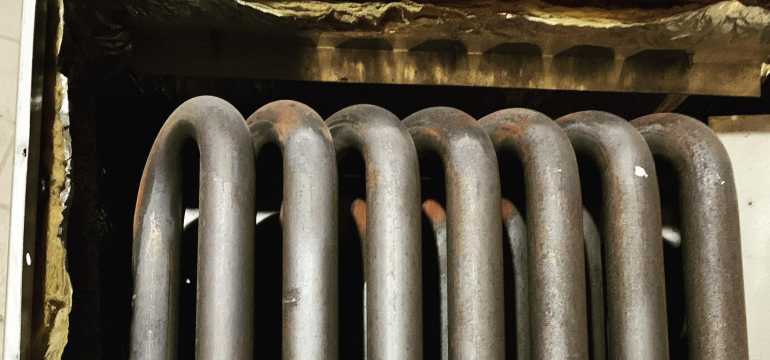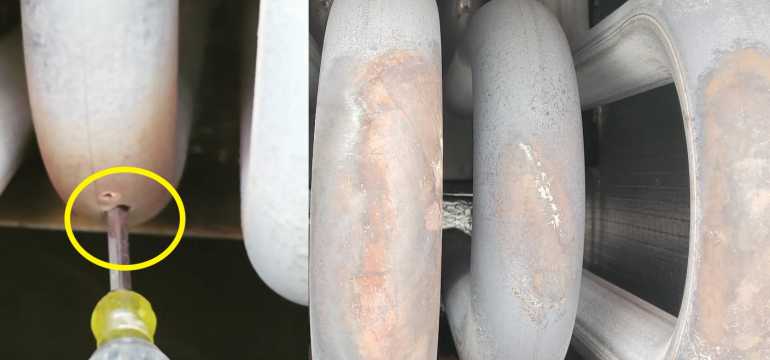Your gas furnace’s heat exchanger is what transfers heat from the exhaust flue gas into your house. It makes sure this transfer happens safely, without leaking any harmful fumes into your home.
But sometimes, a heat exchanger cracks. When this happens, your heater may stop working, and carbon dioxide could leak into your home. There are a few ways to tell if you have this problem.
If your heat exchanger is cracked, you might notice strange smells or a soot build-up around your burners. Other signs include corrosion anywhere on your furnace and audible sounds when the furnace goes on.
But there’s more to learn than that about damaged heat exchangers. That’s why we’ve put together this article. It covers all the ways to know if a heat exchanger has cracked and gives you a solution to it.
Keep reading to learn more.
How can I tell if my heat exchanger is cracked?

There are lots of different signs that you can look for to see if your heat exchanger has cracked.
- The first sign is strange smells. The odor is typically strong and unpleasant. It may smell a bit like formaldehyde.
- You could also look for soot build-up. This would happen around the burners of your furnace.
- Water pooling around your furnace is another sign of a cracked heat exchanger. But this could also be a sign of a condensation problem.
- You may also notice your flame appearance change. A normal furnace flame is blue. If you see orange or yellow, that’s typically a sign that something is off.
- Heat exchangers are made of metal. So they expand and contract when they heat. When the exchanger is cracked, it can create rattling, popping, and banging noises.
- If you start to notice a clicking sound while your furnace runs at its hardest or after the blower fan shuts off, this could be a sign of a cracked heat exchanger.
- A cracked heat exchanger may also cause carbon monoxide to leak into your home. You will be alerted to this by your carbon monoxide alarm going off. Remember, carbon monoxide is a poisonous gas. You should leave your home immediately if your alarm begins going off.
- Poor heating can be another sign that you have a cracked heat exchanger. Even if you don’t notice any efficiency loss, you can look at your utility bill. If it’s higher than usual, that could be a sign your heat exchanger isn’t working properly.
- People in your house experiencing flu-like symptoms can also indicate a failed heat exchanger. That’s because this can cause carbon monoxide leaks, which may produce symptoms like headaches that are similar to the flu.
- Finally, the heat exchanger is not visible until the furnace is opened for routine maintenance. However, corrosion can spread quickly on metal pieces. If there are any parts inside of your furnace that are corroded or rusted, it might be a sign of a damaged heat exchanger.

When the corrosion reaches a certain stage, the heat exchangers become brittle, and cracks may appear. The technicians mostly test them by poking with a screwdriver.
What do I do with a cracked heat exchanger?
If you have a cracked heat exchanger, you need to take action immediately. This issue can cause a carbon monoxide leak in your home. And that can be fatal.
- That’s why the first step is turning off your furnace entirely. This will stop any leak that’s been occurring in your home for the time being.
- The second step is getting in touch with a furnace technician. They can come out and run a combustion gas analysis on your system. This will tell you for sure whether or not your heat exchanger is damaged.
If your exchanger is cracked, you have two options. You can either replace it or replace your furnace entirely.
Generally, it makes sense to replace the entire furnace if your system is nine years old or older. That’s because, at this point, you’re going to start needing more repairs. It’s typically more economical to just pay for the new system to avoid that situation.
Why do heat exchangers crack?
Modern heat exchangers are built to last between 10 and 20 years. They don’t last forever because of the way that heaters work.
Metals expand when heated and contract when cooled. This constant cycle causes wear and tear damage over time. Eventually, this can cause the heat exchanger to crack or break entirely.
That being said, proper maintenance can help you avoid these issues for as long as possible. The installation process also needs to be done correctly. If it’s not done right, then you could have a cracked heat exchanger faster than normal.
That being said, there are a few different reasons why your heat exchanger might crack. Here’s a look at five of the most common factors that cause this problem.
1. Old age
Perhaps the most common cause for a ruptured heat exchanger is old age. As noted above, these parts aren’t meant to last forever. So unless you replace your heater before the heat exchanger cracks, it will happen eventually.
More specifically, a heat exchanger should last between 15 and 18 years on average. If your heater is about that old and you’re experiencing these problems, it might just be old age that cracked the heater exchanger.
If this is the cause of your problem, then you’re almost definitely going to want to replace your entire furnace. Otherwise, you’re likely to continue having these types of issues until you do.
2. Water leaking from AC
Problems with your AC could actually lead to your heat exchanger furnace cracking as well.
You might not expect this to be the cause. But when water leaks from your AC, it drips into your system. This can create internal equipment damage and rust.
When your heat exchanger starts developing rust, it becomes weaker. That could speed up the amount of time that it takes to crack.
It’s why, if you notice water leaking from your AC unit, you should be proactive about fixing it. If left unchecked, that water could end up threatening the integrity of your entire HVAC system.
3. Dirt and decay
Dirt and dust also damage the strength of your heat exchanger over time. When these things accumulate, lots of bad things happen.
For example, with too much dirt and dust in your system, you might have problems with your:
- Air filter
- Blowers
- Coils getting clogged
The bottom line is that this creates a situation where air can’t pass through the system to be heated. And when that happens, the burners emit heat without being able to absorb it.
This can create a situation that puts a lot of stress on your heat exchanger. Over time, that could lead to it cracking.
That’s why it’s important to be proactive about furnace maintenance. You should clean out your vents and replace your air filters regularly. Otherwise, problems like this will probably continue emerging.
4. Airflow problems
Proper airflow is vital to the health of your HVAC system. You shouldn’t close more than 20% of the registers. When air doesn’t flow through the furnace correctly, it overheats.
When that happens, it places more stress on the heat exchanger’s metal. This has the net effect of speeding up the process at which the exchanger decays. And that could cause it to crack sooner than it would under normal circumstances.
5. Improper furnace size
Many people don’t realize that the size of your furnace is extremely important. Your furnace size needs to match the size of your house. Otherwise, the system might crack much faster than it should.
When a furnace is too large for your home, the thermostat shuts down before it completes a full heating cycle. This can create a situation called short cycling. And that can place more strain on your system than you want.
Oversized furnaces are also tied to condensation problems. That’s because oversized furnaces turn off and on too quickly. And that doesn’t give the condensation they create enough time to evaporate.
Over time, this creates rust. And that can cause your heat exchanger to rupture if left unchecked for too long.
When a furnace is too small, it can’t generate enough warmth to heat your home properly. That causes it to operate for longer in order to compensate for the lack of power.
This is a problem because it means that your heat exchanger will be in use more often than it should be. Wear and tear increases, overheating becomes more likely, and your heat exchanger may crack because of it.
How much does it cost to repair a cracked heat exchanger?
Unfortunately, it’s not possible to repair a cracked heat exchanger. If you have this problem, then you’re going to need to replace the exchanger entirely.
The good news is that sometimes this problem will be covered by your manufacturer’s warranty. If it is, then you will probably only have to pay for the labor costs of the repair. And this should run you about $500.
But if your system is older, then it probably isn’t under warranty still. In that case, you would be responsible for paying the entire cost of the repair out of pocket. The amount should be between $1,400 and $2,200.
Is a cracked heat exchanger dangerous?
A cracked heat exchanger can be very dangerous. There are a few reasons for this.
First, a cracked heat exchanger will often leak carbon monoxide, sulfur dioxide, and nitrogen dioxide. All of these gases can lead to issues like:
- Disorientation
- Eye and nose irritation
- Sleepiness
- Flu-like symptoms
- Even death
Every year, about 50,000 people in the United States end up in the emergency room due to carbon monoxide poisoning. You may end up in the same place if you continue running your furnace with a cracked heat exchanger.
Additionally, running your heater with a cracked exchanger can really damage the system as a whole. It brings down the efficiency of your HVAC unit and increases your heating bill.
For all of these reasons, it’s important not to run a furnace if you suspect that it has a cracked heat exchanger. The solution is to turn off the heater and call a professional out to solve the problem.
- What to Do if Your House Smells Like Gas but There’s No Leak - February 6, 2023
- Why Is There a Burning Smell Coming From My Vents? - August 16, 2022
- How to Remove the Musty Smell From Your Air Conditioner - August 16, 2022

